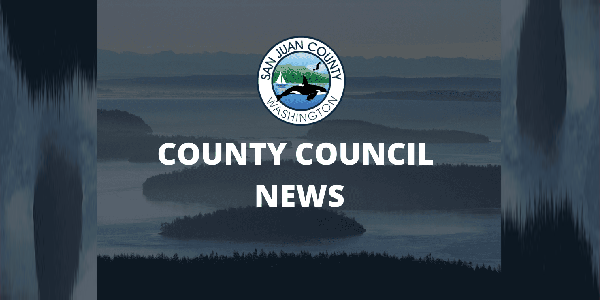||| BY MATTHEW GILBERT, theORCASONIAN OP-ED REPORTER |||
On May 18, Director of Community Development Erika Shook gave council members four options for establishing countywide and/or island-specific caps on vacation rental permits (excluding Friday Harbor). Driving those options, she explained, were “logical possibilities related to actual numbers.” She also emphasized that these options are designed as starting points for discussion.
As itemized in her Staff Report:
Option 1: Countywide Cap – Floating
“The number of vacation rental permits outside of the Master Planned Resort (MPR) designation in any given year shall not exceed 8% of total housing units existing as of December 31 of the previous calendar year.” Under this scenario, and based on mostly updated 2020 data, the number of new permits would have been 35 – 40, determined by a lottery.
Option 2: Countywide Cap – Fixed
“The number of vacation rental permits countywide outside of the Master Planned Resort (MPR) designation shall not exceed a total of 1,445, and no more than 29 vacation rental permits shall be issued in any given year.” This figure is based on an estimated 18,000 housing units by the end of the 15-year “planning horizon” (1,445 is 8% of 18,000).
Option 3: Floating Cap by Island (unrelated to a countywide cap)
“The number of vacation rental permits issued in any calendar year on [San Juan/Orcas/Lopez] Island shall not exceed 8% of the total number of permits for single family residences issued on [San Juan/Orcas/Lopez] Island as of December 31 of the previous calendar year.” This is the most restrictive option, which would have resulted in less than 10 new permits in 2021.
Option 4: Floating Cap by Island (as allowed under a countywide cap)
“The number of vacation rental permits issued in any calendar year on San Juan Island shall not exceed 34% of the total number of permits allowed to be issued in a given year under Option A or B.” On Orcas, the portion would be 33%; on Lopez, 15%. The number of permits allowed in 2021 under this scenario would have fallen somewhere between Option 1 and Option 2. Shook concluded that, “Yearly calculations are more difficult and time-intensive. The simplest option is to select fixed numbers rather than rely on annual calculations.”
“I feel most comfortable with an overall fixed county cap as well as island caps,” responded Cindy Wolf. “The reason is that if we tie VR permits to the building of housing stock, there is no guarantee that new housing stock will bring new workers. If we are prioritizing for community and the ability to provide good service to our visitors, it’s important not to overtax our infrastructure. Under Options A and B, we could easily reach 600 VRs just on Orcas by 2036. Orcas already has half of all VRs in the county. A 500-permit cap on Orcas is a reasonable number, which is more than we have now.” Though not by much: There are currently 491 permitted VRs on Orcas, compared to 382 on San Juan and 130 on Lopez.
Christine Minney agreed that “a countywide fixed cap is a good starting point . . . something that we can send back to the Planning Commission (for further consideration).” She then added, “I wholeheartedly agree that we need a fixed cap by island . . . because the impacts are very different.”
Jamie Stephens asked if the cap “would take into account permits that were abandoned or given up?” Shook assured him it would, to which Stephens then responded that he agreed with the points raised by Minney and Wolf.
Minney then asked if it was possible to limit permits by land use or neighborhood. “This can be addressed in the Comprehensive Plan,” replied Wolf.
“Saturation,” said Stephens, “has been more of a problem than the overall number.”
To add your comments to the discussion, Council members can be reached at the addresses below:
**If you are reading theOrcasonian for free, thank your fellow islanders. If you would like to support theOrcasonian CLICK HERE to set your modestly-priced, voluntary subscription. Otherwise, no worries; we’re happy to share with you.**








Any cap based on a percentage relative to growth… is not a cap at all. We deserve better than this!
None of those four options make any sense at all. If the goal is to limit the number of tourists on the island, then ALL the vacation rental housing stock needs to be accounted for. By any one of these poorly thought out options, there is nothing to stop a motel or hotel from being built or expanded. If vacation rentals are being targeted for additional regulation then ALL vacation rentals should go into the calculation AND the campsites at Moran St. Park. With 150+ campsites, there are at least 150 car loads of tourists on the island every day in the summer simply from Moran’s campsites. You think they don’t use water and produce trash? Or clog up the road and ferry? Trying to limit the number of tourists by additional regulations on the rights of property owners to do as they see fit with the property that they own, without also acknowledging the tourists that are staying at hotels, inns, B&Bs and the State parks is disingenuous in the extreme.
The false claim that vacation rentals are the reason for high housing prices is simply that; false. No one is going to buy a million dollar home and rent it out as ‘affordable housing’. They might rent it out as a VR so that they can afford to own the property and still have the use of it for a portion of the year. No one in their right mind would buy a property at Orcas island prices to rent it out as a VR as a business venture; it’s simply not economically viable.
The end result of this scapegoating of VRs for all the island’s ills will result in only the rich visiting here. Is that what you really want?
Ken, calm down. Just because you raise justifiable comments and have been in the business of knowledge base criteria… you are over reacting.
It’s much easer to do what’s being purposed.. kick the ball as far down the road as possible. The End Result will be less compliance, if the rules change to midegate just a piece of the problem physics and enertia kick in.
This isn’t rocket science, yet WE think we can be clever and rewrite our governance. I liken it to our poor attempt of dealing with the GMA. If we can’t figure it out, let’s round down our numbers.
And now we ponder Urbin Sprawl.
This people stuff is hard!!